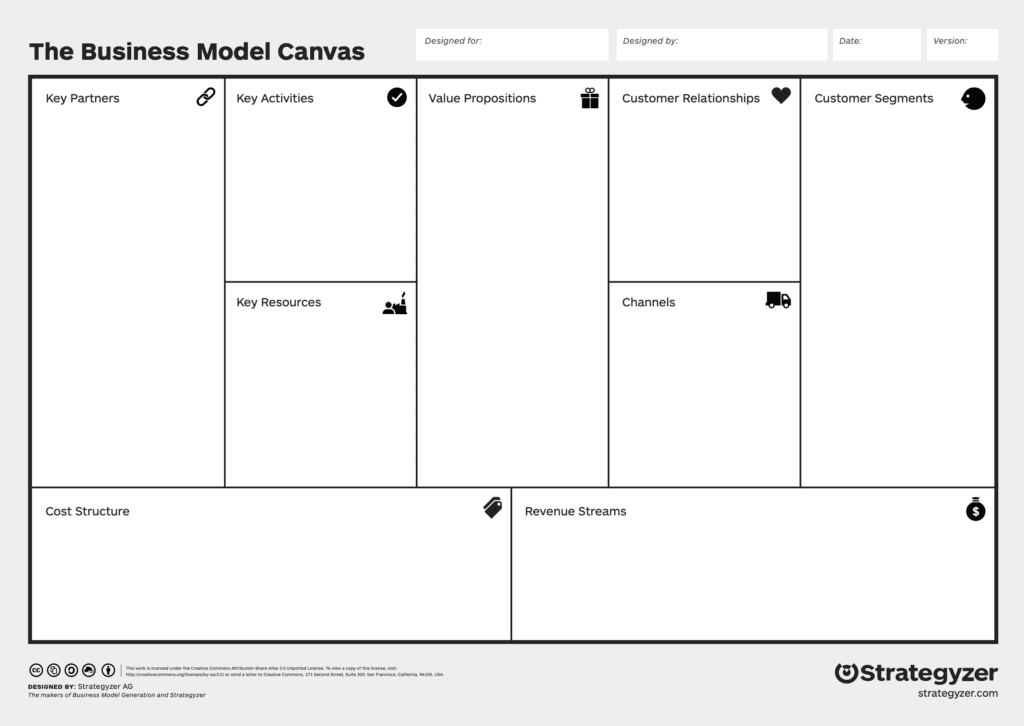Building blocks of the business model canvas
A business model describes the value an organization offers to its customers. It illustrates the capabilities and resources required to create, market and deliver this value, and to generate profitable, sustainable revenue streams.
Identifying and implementing a sustainable business model is one of the major steps towards creating a business. The process of identifying the business model should be preceded by that of developing a clear and succinct value proposition.
This article describes the building blocks of Osterwalder’s business model canvas.




The steps below will help understand how to describe your business model using Osterwalder’s framework.
Part 1: The Offering
- Value proposition: Start by formulating your value proposition. It is the central piece that illustrates how you plan to bind the supply side with the demand side. You can read more about this in the article entitled Value proposition.
Part 2: The Customer Side
- Customer segments: Defining your value proposition leads naturally into a discussion about who your target customer is and what characterizes the ideal customer. Specifically, you should have a clear understanding of your target customer’s motivation to buy.
- Customer relationships: Consider the kind of relationship you want to have with each customer segment. Does your offering lend itself to a more transactional, one-off relationship, or will it be an ongoing relationship that should be organized with some sort of subscription or ongoing contract? Is repeat buying important for your success? And consider what kind of relationship your customer would like to have with your company and your product.
- Channels: Consider how you will reach your customers. Keep in mind that your offering in combination with the relationship you would like to have with your target customer has strong implications for your choice of distribution channel. The trade-off you have to make is basically about balancing the complexity of your solution with the complexity of your marketing. You can read more about this in the article entitled Distribution.
Part 3: The Infrastructure
- Key activities: List your key activities and core capabilities―the assets that you bring to the table when you create your offering. These include technology, patents, assets and expertise that make you unique and can be leveraged. Some of the “strengths” identified in a SWOT analysis can be considered a core capability.
- Key partners: Building your offering may involve third parties and suppliers who have key capabilities to complement yours. It is critical to understand how to integrate these in both your offering and your processes. See Partnering for more details.
- Key resources: Describe how all the components together create your product and serve your customers. Explain the most important activities and processes needed to implement your business model, including critical tasks and timelines, the people and skills required, and your company’s core processes.
Part 4: The Finances
- Revenue streams: Evaluate the streams through which you’ll earn your revenues from value-creating and customer-facing activities. Consider your channels and the types of revenue they will generate for you. Will you focus on bulk sales, unit sales, or services? Will the revenue come from recurring or one-off transactions?
- Cost structure: Calculate the costs you’ll incur to run your business model as determined by its infrastructure (above). Does the cost structure offer you a reasonable profit?
Note that examining the finances at the end of this process allows you to ensure that you have a balanced business model which produces value for your customers and profits for your shareholders at the same time.
Developing your business model
Identifying a sustainable business model is a critical but sometimes difficult step for many startups. While filling in the business model canvas may be a quick exercise in and of itself, ensuring that the business model can be implemented in a way that it supports a viable business is an entirely different matter, simply because much of the information is based on a range of assumptions.
A way of garnering the information required to identify and implement a sustainable business model is to engage in the customer validation process as described by Steven G. Blank in his book, The Four Steps to the Epiphany. The customer validation process is a step-by-step approach to testing key assumptions regarding the customer acquisition process, such those involving one’s sales process, pricing and revenue model.
In addition to assisting with process of designing the business model, the customer validation process also helps generate insights that will enable your marketing communications activities.
References
Blank, S.G. (2005). The Four Steps to the Epiphany. Self-published: Cafepress.com.
Osterwalder, A. & Pigneur, Y. (2009). Business Model Generation. Self-published.

